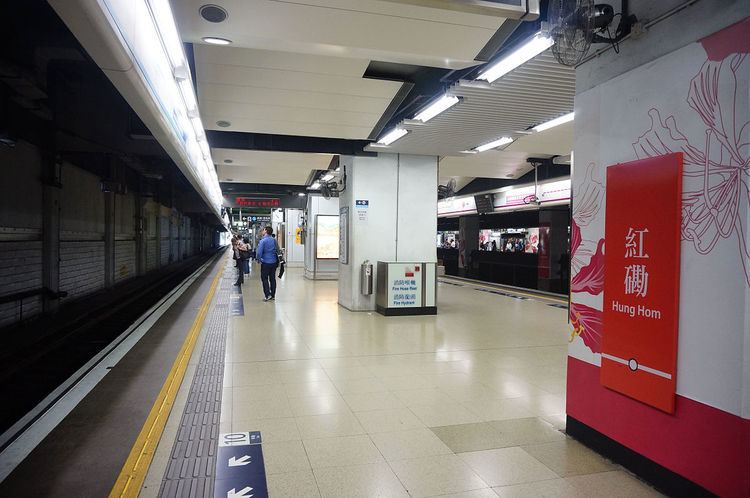Traditional Chinese 紅磡 Cantonese Yale Hùngham Hanyu Pinyin Opened 30 November 1975 Tracks 7 | Simplified Chinese 红磡 Hanyu Pinyin Yale Romanization Hùngham Level 1 | |
 | ||
Address Hong Kong, Yau Tsim MonOn Wan Rd Owner Kowloon-Canton Railway Corporation Platforms in use 7 (3 island platforms and 1 side platform) Similar Lo Wu Station, Lok Ma Chau Station, Kowloon Tong Station, East Tsim Sha Tsui Station, Austin Station | ||
Mtr hd 60 fps east rail line kinki sharyo sp1900 emu train departs hung hom station 9 22 16
Hung Hom (Chinese: 紅磡; Cantonese Yale: Hùngham), referred to by China Railway as Kowloon (Chinese: 九龍車站; Cantonese Yale: Gáulùng Chējaahm), is a station on the East Rail Line and West Rail Line in Hong Kong. It is currently Hong Kong's only station serving cross-border trains to Mainland China. Cross-border services to Beijing, Shanghai, and Guangzhou including Guangzhou-Kowloon Through Train terminate here.
Contents
- Mtr hd 60 fps east rail line kinki sharyo sp1900 emu train departs hung hom station 9 22 16
- Hung hom station hong kong
- History
- The old Hung Hom Station
- Future development
- Exits
- References
The station is located in Yau Tsim Mong District, Kowloon, next to the Cross-Harbour Tunnel's northern entrance. Hung Hom is one of the three Hong Kong ports of entry on the MTR network; the others are Lo Wu and Lok Ma Chau.
Hung hom station hong kong
History
The old Kowloon Station in Tsim Sha Tsui began operation in 1910. After decades of economic growth in Hong Kong, the station, situated at the seafront of Victoria Harbour, became too small and had no room for expansion. A new Kowloon Station (the current Hung Hom Station), situated to the east, was officially inaugurated by Governor Denys Roberts on 24 November 1975 as the new terminus of the Kowloon–Canton Railway. However, it did not start operating until a few days later. The old terminal at Tsim Sha Tsui was closed on 29 November 1975. The first passenger train pulled out of the new station the following morning at 8:26 am. On 5 May 1975, Queen Elizabeth II unveiled a plaque commemorating the opening of the new terminal. The new station cost HK$150 million and offered modern new facilities including a spacious waiting hall, a restaurant, a bar, a bookstore, a bank, escalators, and closed circuit television. It was built along with a bus terminus and a multi-storey car park.
The controversial demolition of the old station commenced on 7 June 1978; a new complex of a concert hall and museums were built on Kowloon Station's original site, but the clock tower was preserved as a Declared Monument.
The new station was renamed Hung Hom Station around February or March 1996. The Kowloon-Canton Railway was renamed KCR East Rail in 1996, and subsequently the East Rail Line upon the merger of MTRC (metro services) and KCRC (suburban train services) in December 2007.
A HK$1.3 billion expansion of Hung Hom Station began on 16 March 1995, which included a new concourse designed by Foster and Partners. The expansion was completed in 1998. The passenger terminal now hosts ticket offices, waiting areas, shops and restaurants.
After decades of being the terminus station of the East Rail Line, Hung Hom temporarily became an intermediate station when the East Rail was extended to East Tsim Sha Tsui Station. This symbolic return to Tsim Sha Tsui of the then-Kowloon–Canton Railway was followed by the inauguration of a westward Kowloon Southern Link to complete the West Rail Line. On 16 August 2009, East Tsim Sha Tsui was transferred to the West Rail Line. Hung Hom regained its status of terminus station, now of both railways.
The old Hung Hom Station
An old Hung Hom station existed on Chatham Road South before the relocation of then-Kowloon Station in 1975. It was situated next to the former coastline of Hung Hom Bay, at the southeastern corner of the Gun Club Hill Barracks (between the current-day Chung Sze Yuen Building A of Hong Kong Polytechnic University and the Hong Kong History Museum).
This old Hung Hom Station, a temporary wooden structure, began operation from the first day of Kowloon-Canton Railway on 1 October 1910 to 15 September 1921, but was later demolished.
Future development
Currently an interchange station between the West Rail Line and East Rail Line, Hung Hom station would be an intermediate stop on the Sha Tin to Central Link, a suburban railway line connecting Sha Tin to Hong Kong Island.
In the latest recommendations by the Legislative Council of Hong Kong, the East Rail Line would be extended to Hong Kong Island to form a North South Corridor, whereas the West Rail Line, the Ma On Shan Line, and the planned East Kowloon Link would be connected as an East West Corridor.
Exits
An interchange for buses (lower level) and public light buses and taxis (upper level) is located outside the station building. The lower-level bus station is situated at the Kowloon entrance of the Cross-Harbour Tunnel. Elevated walkways connect the station to the Hong Kong Coliseum; Hong Kong Polytechnic University; the residential area of Hung Hom; and tourist attractions in eastern Tsim Sha Tsui, such as the Science Museum and the Avenue of Stars along Victoria Harbour.
